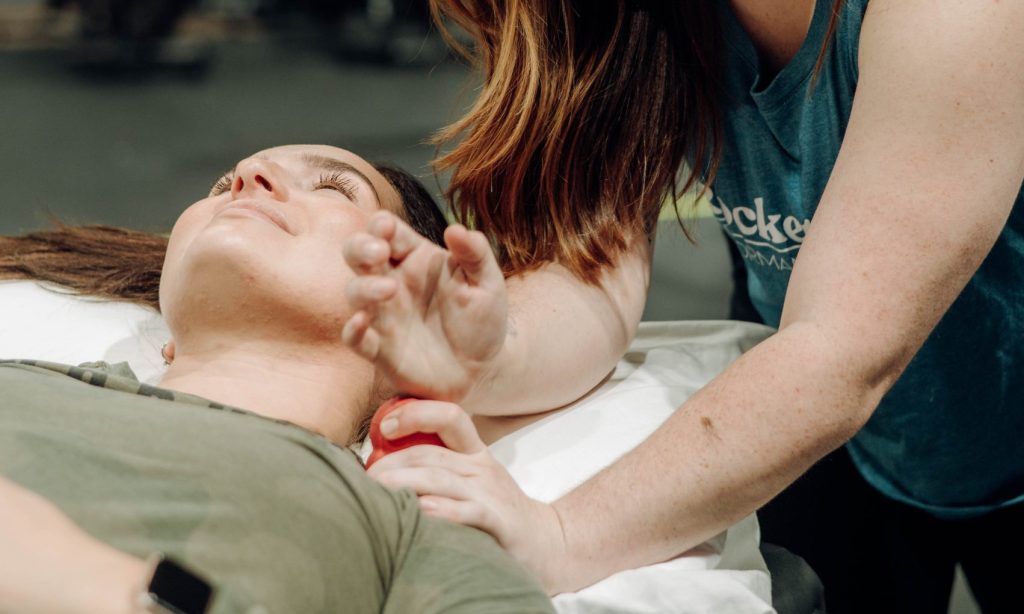If you’ve been struggling with shoulder pain, you’re not alone. Whether you’re an athlete, a weekend warrior, or simply someone who spends long hours at a desk, shoulder discomfort can be a frustrating barrier to movement and performance. One of the most common culprits behind shoulder pain is muscle imbalance—tightness in the chest muscles combined with weakness in the stabilizing rotator cuff muscles.
Today, we’re diving into three essential exercises that help address these imbalances: the Pec Wall Slide Stretch, the Supine 90/90 External Rotation, and the Sitting 90/90 External Rotation. These exercises work together to improve mobility and stability, making them a great starting point for anyone looking to relieve shoulder pain and improve function.
Why Shoulder Mobility and Stability Matter
The shoulder joint is the most mobile joint in the body, but this mobility comes at a cost—it also requires a high level of stability to function correctly. Many people experience pain due to tightness in the pectoral muscles (which pull the shoulders forward) and weakness in the rotator cuff (which stabilizes the joint). Over time, this imbalance can lead to impingements, reduced range of motion, and even injury.
By incorporating targeted stretching and strengthening exercises, you can restore proper function and reduce your risk of pain and injury.
Exercise 1: Pec Wall Slide Stretch
Why It’s Important
Tightness in the pectoralis major and minor muscles can pull the shoulders forward into a rounded position, limiting overhead mobility and contributing to shoulder impingement. Stretching these muscles helps open up the chest and allows for better shoulder positioning.
How to Perform the Pec Wall Slide Stretch:
- Find a Wall: Stand next to a wall and place your forearms against it at shoulder height, forming a goalpost shape with your arms.
- Slide Up and Out: Slowly slide your arms up and slightly outward while keeping your chest open.
- Hold the Stretch: When you reach your end range, pause and hold the position for 5-10 seconds before returning to the start.
- Repeat: Perform 10 slow, controlled repetitions.
What You Should Feel
You should feel a gentle stretch across your chest and the front of your shoulders. Avoid arching your lower back or shrugging your shoulders as you perform the movement.
Additional Benefits
- Improves posture by counteracting forward-rounded shoulders
- Enhances overhead mobility for activities like lifting, throwing, and pressing
- Reduces shoulder impingement risk
Exercise 2: Supine 90/90 External Rotation
Why It’s Important
This exercise focuses on improving range of motion by using gravity to assist external rotation. Limited external rotation can contribute to impingement and dysfunctional movement patterns. By gradually increasing range, this exercise helps prepare the shoulder for more advanced strengthening work.
How to Perform the Supine 90/90 External Rotation:
- Lie on Your Back: Position yourself on a flat surface with your arm supported in a 90-degree elbow bend and 90-degree shoulder flexion.
- Slowly Rotate Back: Keeping your elbow in place, rotate your forearm backward toward the floor.
- Pause at End Range: Hold the position for 5-10 seconds before returning to the start.
- Repeat: Perform 10 reps per side.
What You Should Feel
You should feel a gentle stretch and gradual improvement in your ability to externally rotate the shoulder. Avoid forcing the movement or arching your lower back.
Additional Benefits
- Enhances passive range of motion in the shoulder joint
- Reduces stiffness that contributes to pain and mobility restrictions
- Prepares the shoulder for active strengthening exercises
Exercise 3: Sitting 90/90 External Rotation
Why It’s Important
Strengthening the posterior rotator cuff is crucial for shoulder stability and injury prevention. This exercise actively strengthens the external rotators, which help balance the forces acting on the shoulder joint. Performing this exercise in various degrees of shoulder abduction targets all areas of the external rotators.
How to Perform the Sitting 90/90 External Rotation:
- Sit with Good Posture: Sit on a bench or chair with a resistance band anchored at your side.
- Set Up Your Arm: Hold the band with your elbow bent at 90 degrees and your shoulder at 90 degrees of abduction.
- Rotate Outward: Slowly rotate your forearm backward while keeping your elbow at shoulder height.
- Hold & Control: Pause at your end range for 2-3 seconds, then return to the start.
- Repeat: Perform 10-15 controlled reps on each side.
What You Should Feel
You should feel activation in the posterior rotator cuff muscles. Avoid shrugging your shoulders or compensating with your back.
Additional Benefits
- Strengthens key stabilizing muscles in the shoulder
- Enhances shoulder control and reduces injury risk
- Can be adjusted to different angles for comprehensive rotator cuff activation
How These Exercises Work Together
By incorporating the Pec Wall Slide Stretch, Supine 90/90 External Rotation, and Sitting 90/90 External Rotation, you address both mobility and stability—two essential components of shoulder health. The stretch helps to lengthen the tight chest muscles, the passive external rotation improves range of motion, and the strengthening exercise builds resilience in the rotator cuff.
For best results, try incorporating these exercises into your routine 3-4 times per week. If you’re experiencing persistent shoulder pain or discomfort, a physical therapist can help assess your specific needs and tailor a plan for you.
Final Thoughts
Shoulder pain doesn’t have to limit your movement or performance. By understanding the role of muscle imbalances and incorporating targeted exercises, you can take control of your shoulder health. Give these exercises a try, and let me know how they feel!
Want a step-by-step guide to overcoming shoulder pain? Download my free Shoulder Pain Guide for expert tips and more strategies to help you move pain-free. If you need personalized care, DM me @brethedpt on Instagram or visit Rocket City Performance Therapy to inquire today.

